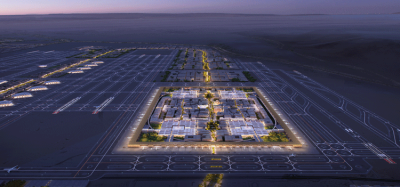Leaders’ Series 2023: Khalil Lamrabet, Greater Toronto Airports Authority
- Like
- Digg
- Del
- Tumblr
- VKontakte
- Buffer
- Love This
- Odnoklassniki
- Meneame
- Blogger
- Amazon
- Yahoo Mail
- Gmail
- AOL
- Newsvine
- HackerNews
- Evernote
- MySpace
- Mail.ru
- Viadeo
- Line
- Comments
- Yummly
- SMS
- Viber
- Telegram
- Subscribe
- Skype
- Facebook Messenger
- Kakao
- LiveJournal
- Yammer
- Edgar
- Fintel
- Mix
- Instapaper
- Copy Link
Posted: 11 December 2023 | Khalil Lamrabet | No comments yet
For Issue 3 2023 of International Airport Review, Khalil Lamrabet, Chief Commercial Officer at Greater Toronto Airports Authority, explained how airports are runways to growth and can power local economic take-off.
You might consider an airport a pit stop between points A and B. But to classify it as such is to misunderstand both functional reality and potential. Take Singapore’s Changi Airport. As Prime Minister Lee Hsien Loong said of the ongoing Terminal 5 expansion project, an airport can and should function as its own airport city — a place for tourists and locals alike to enjoy as a destination in its own right.
Driving airport economic impact
From Southeast Asia to North America, the billions of people who pass through airports annually are more than passengers. They are key economic decision-makers in their communities — drivers, riders, shoppers, diners, customers and patrons of the many thousands of businesses in or affected by the travel business. Airports have tremendous potential to stimulate new economic activity and prosperity, but we have to remember that facilities like Changi, Dubai Airport or Heathrow are more than just transit nodes — they are bona fide economic hubs, driving impact in the cities and communities they serve.
That impact needs to be maximised through employment, commerce and technology. Here are three ways that airports can improve their function while driving economic impact for the communities they serve.
Turn on the taps for talent
It’s hard to overstate the breadth of job creation that airports fuel. Toronto Pearson Airport, where I work, serves as a home base for more than 400 companies. Before the pandemic, Pearson supported more than 50,000 jobs — only 1,500 of which were at the airport authority itself. New York’s JFK reportedly supports 300,000 jobs supporting $16 billion (U.S.) in annual wages.
These kinds of employment numbers translate to quantifiable economic gains that are very sticky for local and regional communities, because airport work can’t readily be performed remotely. Before the pandemic, Canadian airports contributed CA$35 billion to the GDP. U.S. airports generated $1.4 trillion in economic activity.
These benefits require a wide variety of people and talents, because whatever size your airport is, it takes a village to run it. Toronto Pearson employs baggage-system Mechanics, Electricians, Firefighters and Deicing Technicians. But we also have Legal Counsels, Communications Specialists, Dining Development Managers – and a Falconer. Aviation leaders can embrace and expand on this variety to create more growth opportunities in unexpected areas – say, by leasing more retail or events space, or engaging peer airports for operational consulting services.
Connect buyers and sellers while managing experiences
There’s a saying in aviation: “Treat your passengers like customers”. That mentality has created myriad touchpoints between businesses and the people who need them, setting the global airport retail market on pace to balloon to $72 million by 2028. We can push that growth even further by embracing the omnichannel nature of modern shopping.
In a world where a Chrome extension can calculate the best deal on travel adapters with one click, duty-free shopping has lost some lustre. Airports can keep pace — and diversify revenue — by allowing customers to shop online like they’re used to. It’s a practice well underway from Shanghai and Paris to London and New York.
If the trend for airports has been to treat passengers like customers, today passengers need to be treated like guests — airports are not operating in the transportation industry only, but they are competing in the entertainment and hospitality ecosystem. The passenger should be the centre of everything the airport does. For instance, Dallas Fort Worth Airport, recently introduced AI and automation solutions to deliver a more personalised and seamless passenger care experience. The airport, home to more than 200 stores and restaurants, has also recently collaborated with retailers to introduce grab-and-go technology that simplifies the customer journey. The New Laguardia Terminal B, is another example of a terminal designed and built with the passenger in mind, offering world-class travel experiences by leveraging various dimensions: art, space, F&B offering and entertainment.
Innovate to stimulate
A tech-forward airport experience pays dividends that reach far beyond the terminal doors. A smooth trip to and from the plane can attract visitors to a city, patrons to local establishments, and businesses to available office space. But airports that resist modern technology like artificial intelligence, biometrics, and automation risk turning new business and would-be tourists away from their cities.
When aviation leaders understand the broad impact of their organisational operations, airports begin to function as testing grounds for creative applications of new technology. For example, Kansas City International Airport found that airlines and businesses were avoiding the area due to an outdated experience. They responded by modernising all terminals, building glass-walled jet bridges, and installing a flight simulator to put nervous travellers at ease. Columbia Metropolitan Airport, noting that more than half of airports’ non-aeronautical airport revenue comes from parking, has introduced digital parking in partnership with GOairports.
Across North America and beyond, we’re seeing the emergence of airport innovation that fits into the passenger journey while fuelling economic activity in the larger community. Last year, a survey by ACI World and SITA found that 86% of airports around the world plan further investment in self-service technology by 2025. This kind of enthusiastic tech exploration can lay the groundwork for the communities surrounding these airports to evolve into innovation centres.
Airports enable these economic connections in their communities, and we need to pay attention to the potential benefits. Billions of people pass through our airports every year, and their time in the terminals is more than a pit stop between destinations — it’s an opportunity for exposure to and investment in the services and technology that power growth.


Issue
Related topics
Airport cities, Airport development, Social responsibility, Workforce
Related airports
Dallas Fort Worth International Airport (DFW), Kansas City International Airport (KCI), LaGuardia Airport (LGA), Singapore Changi Airport (SIN), Toronto Pearson International Airport (YYZ)

















